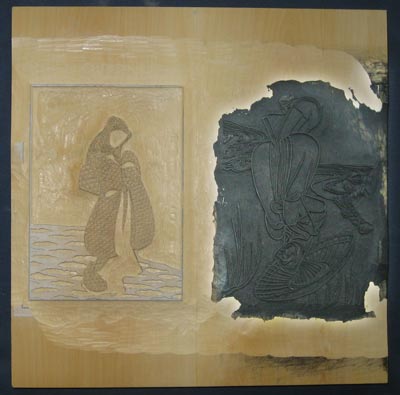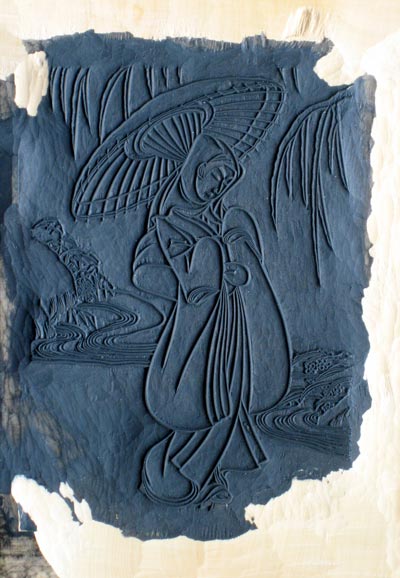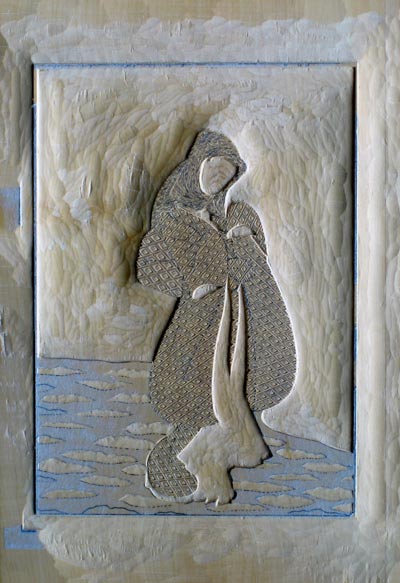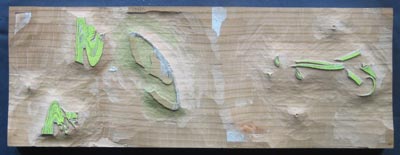Posted by Dave Bull at 5:33 PM, December 31, 2008
My new year 'cards' flew away around a week ago, and I'm already getting 'Got it!' reports from here and there. Those sent to addresses in Japan will all be delivered early tomorrow morning - New Year's Day - as that's how the post office here does it, but overseas ones of course arrive at random times ...
I thought it might be interesting to show the blocks ... in closeup! (All these images can be clicked to bring up enlargements.)
I used a special piece of wood for the keyblock this time; a wide piece of boxwood I prepared some years back and which has been 'curing' here on a shelf since then. It's made of two pieces of boxwood jointed together, and laminated to a firm piece of plywood for stability.
I used this wood for both the keyblock, and for the block used to make the karazuri (embossing). The two carved images are placed 'heads and tails' on the wood, with two sets of registration marks. (The funny white 'halo' around the black area is from my attempt to improve the visibility of the deep black area with Photoshop.)

Here are closer images of the two areas; first the keyblock:

And then the karazuri:

At the time I took those pictures, no prints had yet been made. The keyblock is black because I used it to print a set of kyogo (colour separation sheets). And I also did some cleaning up after that, so the edge of the blackened area is ragged. (That block has since become completely blackened ...)
The karazuri block has not yet been washed, and still shows the paper of the hanshita ...
Here are the six colour blocks. Two pieces of wood, one used on both sides. Again 'heads and tails' with two sets of registration marks. You can see remnants of the kyogo sheets visible, as they haven't been washed at this point.



I printed 192 sheets in the first run (12 sheets of oh-biru size hosho paper, with 16 cut from each sheet). Registration was extremely tight, as many of the lines of the keyblock are on the order of 0.1mm wide. There is absolutely no margin for error. To help minimize problems, I 'painted' the corner of the paper with nail polish, so that it would 'click' into the registration mark securely. (If you are receiving one of these prints, you can touch the bottom right corner to test this ...) I also put a touch of the polish at the place where the paper rests against the other registration mark.
As for an image of the print itself, it's still too early for me to show that, but it will be uploaded to my New Year Cards page on the morning of the 1st ...
Hi Dave,
I really appreciate that you give us a window into how you do what you do. For me, it makes the final products, the prints, so much more enjoyable to view. Thank you very much!
I wish you a happy, healthy, and prosperous new year.
Best regards,
Marc

Just received this print and it is superb! Look carefully and you will see the intricate embossing patterns, and unbelievably minute detail, such as the the hair and facial features of the girl, so delicate it would seem impossible to carve, much less print. Excellent job Dave, this is an absolute gem!

Dave,
As usual your work amazes me. What a perfectly lovely print.
I love what I do as a printmaker and I love what you do as well. Printmaking sure can take over ones life. It is like some sort of parallel universe only artists live in.
My best
Barbara

Hi Dave,
Is this the image called "The Heron Maiden"?
I have a nice little book showing the stages of printing, including an embossed page.
I don't really know the story, but is she turned into a heron, or something like that?
Happy New Year,
Mark.

Is this the image called "The Heron Maiden"?
As far as I can tell, this isn't really a Harunobu at all, but an image 'ripped off' from some of his other work. I've hunted through all my books on Harunobu, and although there are other images tagged with the Heron Maiden theme, none of them match this scene. There is, however, a famous image of a couple sharing an umbrella (he in black, she in white).

This was reproduced by other publishers, even during Harunobu's lifetime. Here's another version from that era; quite a bit of it has been re-drawn, and it has been enlarged to the o-ban size (most of Harunobu's prints were chu-ban). (This is taken from a poor quality book illlustration; I have no idea if the print itself has these glaring colours.)

The next step I can identify is the Taisho-era 'Harunobu' that I own; the woman is clearly copied from that previous image ... the face, the kimono lines, almost everything is the same, except the umbrella angle, a slight simplification of her kimono around the feet, and the tail of her flowing sash:

And mine is pretty much a straight (greatly reduced) copy of that, with the background slightly trimmed and simplified. My paper is such an 'ugly' white when compared to the beautifully aged Taisho version! One day mine will look like that ... but long after I'm gone! :-(

(When looking at the enlarged versions, and comparing mine with the Taisho original, please remember that mine is postcard size, and the other one is full chu-ban!)
Mark, where does the one in your little book fall along this line?
[Added later] Here is an image from the 'little book' mentioned by Mark above. It is clearly modelled on the Taisho image also (although the text in the book - in English - states that it is 'by' Harunobu). I personally still feel that this is something created by a Meiji/Taisho publisher - an opinion I will change instantly if I come across an image of the same design, but clearly made back in Edo times ...

Friend and collector Jacques Commandeur has scanned his copy and uploaded it to a page on his site.

David do you ever have classes or workshops? I know its long way ,but your work is wonderful and I would love to learn the style and I am sure there are other artist that feel the same way. Thank you, Liz

classes or workshops
No, I'm sorry ... My focus is on making the things! Unlike the situation a couple of decades ago, these days there is a huge amount of information available for people learning about woodblock printmaking.
And because it is - on the face of it - an extremely simple technology, there are no barriers at all standing in the way of someone who wants to experiment and learn.
Tools, materials, and information ... are all readily available. All you have to do, is get started!













